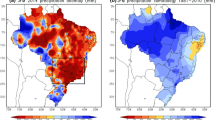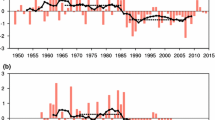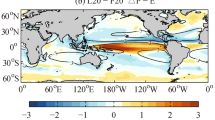Abstract
The severe drought over northeast Asia in summer 2014 and the contribution to it by sea surface temperature (SST) anomalies in the tropical Indo-Pacific region were investigated from the month-to-month perspective. The severe drought was accompanied by weak lower-level summer monsoon flow and featured an obvious northward movement during summer. The mid-latitude Asian summer (MAS) pattern and East Asia/Pacific teleconnection (EAP) pattern, induced by the Indian summer monsoon (ISM) and western North Pacific summer monsoon (WNPSM) rainfall anomalies respectively, were two main bridges between the SST anomalies in the tropical Indo-Pacific region and the severe drought. Warming in the Arabian Sea induced reduced rainfall over northeast India and then triggered a negative MAS pattern favoring the severe drought in June 2014. In July 2014, warming in the tropical western North Pacific led to a strong WNPSM and increased rainfall over the Philippine Sea, triggering a positive EAP pattern. The equatorial eastern Pacific and local warming resulted in increased rainfall over the off-equatorial western Pacific and triggered an EAP-like pattern. The EAP pattern and EAP-like pattern contributed to the severe drought in July 2014. A negative Indian Ocean dipole induced an anomalous meridional circulation, and warming in the equatorial eastern Pacific induced an anomalous zonal circulation, in August 2014. The two anomalous cells led to a weak ISM and WNPSM, triggering the negative MAS and EAP patterns responsible for the severe drought. Two possible reasons for the northward movement of the drought were also proposed.

















Similar content being viewed by others
References
Adler RF et al (2003) The version-2 global precipitation climatology project (GPCP) monthly precipitation analysis (1979-present). J Hydrometeorol 4:1147–1167
Ashok K, Guan ZY, Yamagata T (2001) Impact of the Indian Ocean dipole on the relationship between the Indian monsoon rainfall and ENSO. Geophys Res Lett 28:4499–4502
Chou C, Tu JY, Yu JY (2003) Interannual variability of the western North Pacific summer monsoon: differences between ENSO and non-ENSO years. J Clim 16:2275–2287
Ding QH, Wang B (2005) Circumglobal teleconnection in the northern hemisphere summer*. J Clim 18:3483–3505
Ding QH, Wang B, Wallace JM, Branstator G (2011) Tropical-extratropical teleconnections in boreal summer: observed interannual variability*. J Clim 24:1878–1896
Enomoto T, Hoskins BJ, Matsuda Y (2003) The formation mechanism of the Bonin high in August. Q J R Meteorol Soc 129:157–178
Gill AE (1980) Some simple solutions for heat-induced tropical circulation. Q J R Meteorol Soc 106(449):447–462
Guan ZY, Yamagata T (2003) The unusual summer of 1994 in East Asia: IOD teleconnections. Geophys Res Lett 30:511–514
Guo QY (1992) Teleconnection between the floods/droughts in North China and Indian summer monsoon rainfall (in Chinese). Acta Geographica Sinica 47:394–402
He SP (2015) Potential connection between the Australian summer monsoon circulation and summer precipitation over central China. Atmos Ocean Sci Lett 8:120–126
Huang RH, Li WJ (1987) Influence of the heat source anomaly over the tropical western Pacific on the subtropical high over East Asia. In: Proceedings of the international conference on the general circulation of East Asia (ICGC), Chengdu, pp 40–51
Huang RH, Sun FY (1994) Impacts of the thermal state and the convective activities in the tropical western warm pool on the summer climate anomalies in East Asia (in Chinese). Chin J Atmos Sci 18:141–151
Huang RH, Wu YF (1989) The influence of ENSO on the summer climate change in China and its mechanism. Adv Atmos Sci 6:21–32
Ju JH, Slingo J (1995) The Asian summer monsoon and ENSO. Q J R Meteorol Soc 121:1133–1168. doi:10.1002/qj.49712152509
Kalnay E et al (1996) The NCEP/NCAR 40-year reanalysis project. Bull Am Meteorol Soc 77:437–471
Kim JE, Yeh SW, Hong SY (2009) Two types of strong northeast Asian summer monsoon. J Clim 22:4406–4417
Kosaka Y, Nakamura H (2006) Structure and dynamics of the summertime Pacific-Japan teleconnection pattern. Q J R Meteorol Soc 132(619):2009–2030
Kosaka Y, Chowdary JS, Xie SP, Min YM, Lee JY (2012) Limitations of seasonal predictability for summer climate over East Asia and the Northwestern Pacific*. J Clim 25:7574–7589
Kripalani RH, Kulkarni A (2001) Monsoon rainfall variations and teleconnections over South and East Asia. Int J Climatol 21:603–616. doi:10.1002/joc.625
Kumar KK, Rajagopalan B, Cane MA (1999) On the weakening relationship between the Indian monsoon and ENSO. Science 284:2156–2159
Lau NC, Nath MJ (2000) Impact of ENSO on the variability of the Asian–Australian Monsoons as Simulated in GCM experiments. J Clim 13:4287–4309
Li T, Wang B (2005) A review on the western North Pacific monsoon: synoptic-to-interannual variabilities. Terr Atmos Ocean Sci 16:285–314
Li XZ, Zhou W (2012) Quasi-4-Yr coupling between El Niño-Southern oscillation and water vapor transport over East Asia–WNP. J Clim 25:5879–5891. doi:10.1175/JCLI-D-11-00433.1
Li T, Zhang YS, Chang CP, Wang B (2001) On the relationship between Indian Ocean sea surface temperature and Asian summer monsoon. Geophys Res Lett 28:2843–2846
Li SL, Lu J, Huang G, Hu KM (2008) Tropical Indian Ocean basin warming and East Asian summer monsoon: a multiple AGCM study. J Clim 21:6080–6088
Li XZ, Zhou W, Chen DL, Li CY, Song J (2014) Water vapor transport and moisture budget over Eastern China: remote forcing from the two types of El Niño. J Clim 27:8778–8792. doi:10.1175/JCLI-D-14-00049.1
Li X, Zhou W, Chen YD (2015) Assessment of regional drought trend and risk over china: a drought climate division perspective. J Clim 28:7025–7037
Lu RY (2004) Associations among the components of the East Asian summer monsoon system in the meridional direction. J Meteorol Soc Jpn 82:155–165
Lu RY, Lu S (2014) Local and remote factors affecting the SST–precipitation relationship over the Western North Pacific during summer. J Clim 27:5132–5147
Lu RY, Oh JH, Kim BJ (2002) A teleconnection pattern in upper-level meridional wind over the North African and Eurasian continent in summer. Tellus A 54:44–55
Nitta T (1987) Convective activities in the tropical western Pacific and their impact on the northern hemisphere summer circulation. J Meteorol Soc Jpn 65:373–390
North GR, Bell TL, Cahalan RF, Moeng FJ (1982) Sampling errors in the estimation of empirical orthogonal functions. Mon Weather Rev 110:699–706
Saji NH, Yamagata T (2003) Possible impacts of Indian Ocean dipole mode events on global climate. Clim Res 25:151–169
Saji NH, Gowsami BN, Vinayachandran PN, Yamagata T (1999) A dipole mode in the tropical Indian Ocean. Nature 401:360–363
Shukla RP, Huang BH (2015) Interannual variability of the Indian summer monsoon associated with the air–sea feedback in the northern Indian Ocean. Clim Dyn 46(5):1977–1990. doi:10.1007/s00382-00015-02687-x
Smith TM, Reynolds RW, Peterson TC, Lawrimore J (2008) Improvements to NOAA’s historical merged land–ocean surface temperature analysis (1880–2006). J Clim 21:2283–2296
Sun JQ, Yuan W, Gao YZ (2008) The Arabian Peninsula-North Pacific teleconnetion and its relationship with Asian summer monsoon, (in Chinese). Sci China (Ser D) 38:750–762
Sun XG, Greatbatch RJ, Park W, Latif M (2010) Two major modes of variability of the East Asian summer monsoon. Q J R Meteorol Soc 136:829–841
Vimal M, Smoliak BV, Lettenmaier DP, Wallace JM (2012) A prominent pattern of year-to-year variability in Indian summer monsoon rainfall. Proc Natl Acad Sci USA 109:7213–7217
Wang HJ (2001) The weakening of the Asian monsoon circulation after the end of 1970’s. Adv Atmos Sci 18:376–386
Wang HJ (2002) The instability of the East Asian summer monsoon–ENSO relations. Adv Atmos Sci 19:1–11
Wang HJ, Fan K (2005) Central-north China precipitation as reconstructed from the Qing dynasty: signal of the Antarctic atmospheric oscillation. Geophys Res Lett. doi:10.1029/2005gl024562
Wang HJ, He SP (2015) The north China/northeastern Asia severe summer drought in 2014. J Clim 28:6667–6681
Wang B, Zhang Q (2002) Pacific-East Asian teleconnection. Part II: how the Philippine Sea anomalous anticyclone is established during El Niño development*. J Clim 15:3252–3265
Wang B, Wu RG, Lau KM (2001) Interannual variability of the Asian summer monsoon: contrasts between the Indian and the Western North Pacific-East Asian Monsoons*. J Clim 14:4073–4090
Wang B, Ding QH, Fu XH, Kang I-S, Jin K, Shukla J, Doblas-Reyes F (2005) Fundamental challenge in simulation and prediction of summer monsoon rainfall. Geophys Res Lett 32:291–310
Webster PJ, Yang S (1992) Monsoon and ENSO: selectively interactive systems. Q J R Meteorol Soc 118:877–926
Wei W, Zhang RH, Wen M, Rong XY, Li T (2014) Impact of Indian summer monsoon on the South Asian High and its influence on summer rainfall over China. Clim Dyn 43:1257–1269
Wu RG (2002) A mid-latitude Asian circulation anomaly pattern in boreal summer and its connection with the Indian and East Asian summer monsoons. Int J Climatol 22:1879–1895
Wu RG, Kirtman BP (2007) Regimes of seasonal air–sea interaction and implications for performance of forced simulations. Clim Dyn 29:393–410. doi:10.1007/s00382-007-0246-9
Wu B, Zhou TJ, Li T (2009) Seasonally evolving dominant interannual variability modes of East Asian Climate*. J Clim 22:2992–3005
Wu B, Li T, Zhou TJ (2010) Relative contributions of the Indian Ocean and local SST anomalies to the maintenance of the Western North Pacific anomalous anticyclone during the El Niño decaying summer*. J Clim 23:2974–2986. doi:10.1175/2010jcli3300.1
Wu RG, Chen JL, Chen W (2012a) Different types of ENSO influences on the Indian summer monsoon variability. J Clim 25:903–920. doi:10.1175/jcli-d-11-00039.1
Wu RG, Yang S, Wen ZP, Huang G, Hu KM (2012b) Interdecadal change in the relationship of southern China summer rainfall with tropical Indo-Pacific SST. Theor Appl Climatol 108:119–133
Xie SP, Hu KM, Hafner J, Tokinaga H, Du Y, Huang G, Sampe T (2009) Indian Ocean capacitor effect on Indo-western Pacific climate during the summer following El Niño. J Clim 22:730–747. doi:10.1175/2008jcli2544.1
Xu ZQ, Fan K (2012) Possible process for influences of winter and spring Indian Ocean SST anomalies interannual variability mode on summer rainfall over eastern China (in Chinese). Chin J Atmos Sci 36:879–888. doi:10.3878/j.issn.1006-9895.2012.11176
Yang JL, Liu QY, Xie SP, Liu ZY, Wu LX (2007) Impact of the Indian Ocean SST basin mode on the Asian summer monsoon. Geophys Res Lett. doi:10.1029/2006gl028571
Zhang RH (2001) Relations of water vapor transport from Indian monsoon with that over East Asia and the summer rainfall in China. Adv Atmos Sci 18:1005–1017
Zhou LT (2014) Interdecadal variability in large and small warm pools in western Pacific and their association with rainfall anomalies. Atmos Ocean Sci Lett 7:56–61
Zhu YL, Wang HJ, Zhou W, Ma JH (2011) Recent changes in the summer precipitation pattern in East China and the background circulation. Clim Dyn 36:1463–1473. doi:10.1007/s00382-010-0852-9
Acknowledgements
The authors are grateful to the three anonymous reviewers for their insightful comments that led to a significant improvement of the manuscript. This research was jointly supported by the National Natural Science Foundation of China Grant 41421004, National Natural Science Foundation of China Grants (41325018, 41575079), and CAS/SAFEEA International Partnership Program for creative Research Team “Regional environmental high resolution numerical simulation”.
Author information
Authors and Affiliations
Corresponding author
Rights and permissions
About this article
Cite this article
Xu, Z., Fan, K. & Wang, H. Role of sea surface temperature anomalies in the tropical Indo-Pacific region in the northeast Asia severe drought in summer 2014: month-to-month perspective. Clim Dyn 49, 1631–1650 (2017). https://doi.org/10.1007/s00382-016-3406-y
Received:
Accepted:
Published:
Issue Date:
DOI: https://doi.org/10.1007/s00382-016-3406-y




